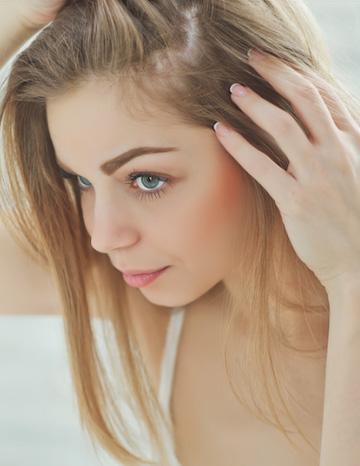
8 minute read
SCALP NY
Treatment:
Advertisement
A doctor will need to treat any underlying causes of telogen effluvium. If a physician suspects that specific medications are causing hair loss at any form, they may change them.
ANAGEN EFFLUVIUM
Anagen Effluvium causes large amounts of hair to fall out rapidly during the growth phase of the hair cycle. The condition may cause hair to fall out from the head, as well as from other parts of the body, including eyebrows and eyelashes, just like chemotherapy treatment.
Treatment:
Treatment for this condition depends on the cause but can include a topical solution of minoxidil. If a person has anagen effluvium as a result of undergoing chemotherapy, cooling the scalp during the procedure may help. Hair will often grow back 3–6 months after stopping chemotherapy.
ALOPECIA AREATA
Alopecia areata is an autoimmune condition that causes hair to fall out suddenly. The immune system attacks hair follicles, along with other healthy parts of the body. Hair from the scalp, as well as eyebrows and eyelashes, may fall out in small chunks.
Treatment:
If a person has this state of being, they should see a physician. A doctor may prescribe medication to help the hair grow back. A receding hairline due to hairs being pulled back into tight hairstyles. Traction alopecia causes it to break and come loose.
Include:
Tight buns or ponytails Braids If traction alopecia continues, a person may develop bald spots and thinning of the hair.
Treatment:
In terms of self-care, avoiding tight hairstyles will usually prevent further damage.
MEDICATIONS
Some medications have side effects that can start hair to fall out. Examples of such medications include: blood thinners, such as warfarin Accutane, to treat acne antidepressants, including Prozac and Zoloft beta-blockers cholesterol-lowering drugs, such as Lopid
Treatment:
If a person thinks hair loss may be due to a medication they are taking, they should consider seeing a physician for an assessment. The doctor might be able to reduce the dosage or switch the person to a different medication.
FRONTAL FIBROSING ALOPECIA
Frontal fibrosing alopecia typically occurs in a receding hairline pattern and may also result in hair loss in the eyebrows and underarms. Frontal fibrosing alopecia most commonly affects post menopausal women.
Treatment:
Certain medications can manage symptoms and stop the progression of the disease. The cause is unknown. Birth control pills
Hair loss while using birth control pills may be a bad experience to some people. Others might suffer hair loss several weeks or months after they stop taking them. If people are taking birth control pills, they can choose one that has a low androgen index. This may help to lower the risk of hair loss. Other forms of birth control that give hormonal changes, such as implants and skin patches, may also cause hair loss.
Treatment:
The American Hair Loss Association recommends that people who have an increased risk of genetic hair loss opt for a non-hormonal type of birth control.
RINGWORM
Ringworm is a fungal infection that can start hair loss. Ringworm on the scalp, or tinea capitis, can cause temporary bald areas on the head, its symptoms include: itchy, red patches of skin, small spots that get bigger and many more.
Treatment:
If ringworm does not heal by itself, then a doctor may prescribe an antifungal medicine. Alternatively, they may prescribe an antibiotic, such as Griseofulvin.
POLYCYSTIC OVARY SYNDROME (PCOS)
A condition that affects a woman’s hormone levels. Women with PCOS

produce higher-than-normal amounts of male hormones. This hormone imbalance causes them to skip menstrual periods and makes it harder for them to get pregnant. Its symptoms include hair loss, depression, and acne. Its risk factors infertility, diabetes, and obesity.
Treatment:
There is no cure for PCOS, but you can manage the symptoms of PCOS with the help of your physician.
REGROWING HAIRLINE
There are a lot of ways to regrow hairlines from scalp massages to taking supplements, and eating a healthy diet. Here are the best and advance methods of the doesn’t require much patience:
Hairline lowering/advance procedure The hairline lowering/advancement procedure is performed by your surgeon making a trichophytic incision along the natural hairline and then carefully moving the scalp forward and downwards on the forehead. The hair-bearing tissue is then moved forward and sutured into its new lower position. After suturing, the individual hair follicles may also be transplanted to fill in gaps and to ensure that the hairline is natural.
HAIR TRANSPLANT
The use of hair transplantation also works to normalize the shape of the new hairline and also to minimize the appearance of any scarring as hair growth manifests through and over the incision line. In most cases, after the hair transplants surgery, there are only a very minimal, barely visible scars at the hairline. This scar will eventually fade to become nearly invisible over time.
PLASMA INJECTIONS
Here’s one we hadn’t heard of before. Platelet-rich plasma injections (PRP) have been used in other fields of medicine for over a decade but have only reached dermatology within the last five years. Simply put, Blood is extracted from the person with hair loss and ‘growth factors’ are extracted from the blood, then injected back into the scalp in the area where hair loss is occurring.
SCALP MICROPIGMENTATION
During the scalp micropigmentation process (SMP), specialists apply an ink to a balding area with microneedles, which create micro impressions to give the illusion of hair. The ink helps replicate the appearance of thicker hair and each formula is mixed to match a person’s natural hair color as much as possible. The best people to ask, how scalp micropigmentation help hair loss is the Scalp International Hairlines, for they are the best professional to choose for your receding hairline problem and, every client that is treated will not leave the final session of treatment without being 100% satisfied – guaranteed!
BOTTOM LINE
In male pattern hair loss (MPHL), the hair loss typically presents itself as either a receding front hairline, loss of hair on the crown (vertex) of the head, or a combination of both. Female pattern hair loss (FPHL) typically presents as a diffuse thinning of the hair across the entire head. loss or even receding hairline affects both men and women’s psyche. This psychological toll affected the woman more that men, obviously. Female pattern hair loss may lead to depression, anxiety, and social phobia.
For more information about Scalp International Hairlines and how we can help both men and woman with hairloss, please visit our website www. scalpny.com.

HELPING MEN AND WOMEN WHO ARE SUFFERING FROM HAIR LOSS, SCARS, AND FORMS OF ALOPECIA BECOME BETTER VERSIONS OF THEMSELVES THROUGH SCALP MICROPIGMENTATION.
2851 MILTON AVE SOLVAY, NY 13209 (800) 236-6792 WWW.SCALPNY.COM



{ SHIFT+CONTROL }{ BLISSFUL BALANCE } THE POWER OF ESSENTIAL OILS
BY CINDY DECAROLIS
In recent years, essential oils have become quite popular and are being sold everywhere from spas, to chiropractors, to Walmart, and at prices that vary greatly. With the price, quality of essential oils varies as well.
Essential oils have been used for thousands of years in religion, marriage ceremonies, cosmetics, perfumes, health practices, and food preparation.
I was first introduced to essential oils around 2005, initially I just dabbled, not really knowing much about essential oils. In 2014, I was introduced to doTerra Essential Oils, that was when I realized that not all essential oils are the same. Since then, I have studied and learned a lot about essential oils.
What are essential oils?
Essential oils are aromatic, volatile compounds found naturally in plants. It is estimated that only about 10 percent of the world’s plants produce essential oils. Essential oils are 50 to 70 times more powerful than herbs.
Essential oils protect the plant from environmental conditions and insects, as well as playing a part in pollination. Essential oils can be found in many parts of a plant, including its roots, bark, seeds, stems, leaves, flowers, and fruit. For example, three essential oils can be extracted from the bitter orange tree: Neroli from the flower of the tree, Petitgrain from the leaves and twigs, and orange from the rind of the fruit. Each
of the three essential oils has a different aroma and chemical constituent profile.
Each essential oil is comprised of many chemical constituents, providing distinctive qualities and healing properties. One of the most commonly used essential oils is lavender, renowned for its calming and relaxing properties.
How are essential oils extracted from the plant?
There are two methods of extraction used, steam-distillation, and for citrus oils, cold-pressing. When done properly and skillfully, these processes will produce a high-grade essential oil with maximum potency and healing benefits.
Steam-distillation uses low-heat pressurized steam to circulate through plant parts and extract oils. Cold-press distillation of citrus oils uses a mechanical press to squeeze essential oils from the rind or peel of the fruit.
Lower-grade essential oils are frequently extracted through chemical processes or with solvents to increase yield and profit.
Why do essential oils work?
Essential oils are compatible and beneficial to humans because both humans and plants are carbon-based. In addition, the molecular size of the active compounds in essential oils are so small that they are able to pass through the dermal layers of the skin and be absorbed directly into the bloodstream, as well as penetrate the








